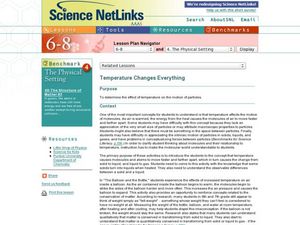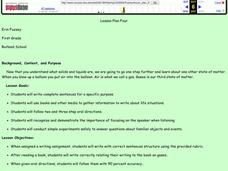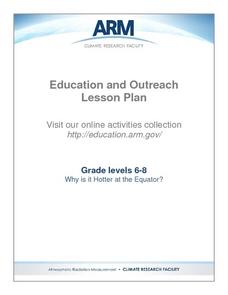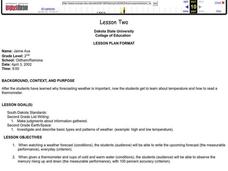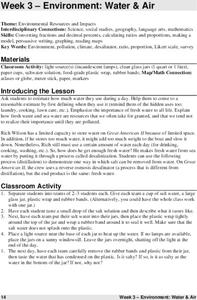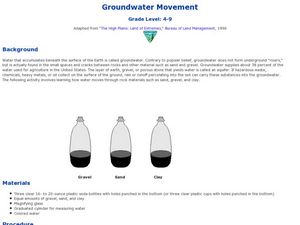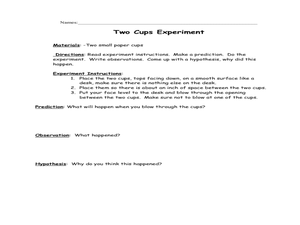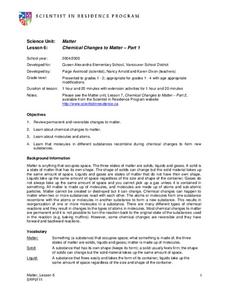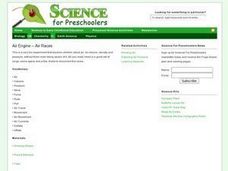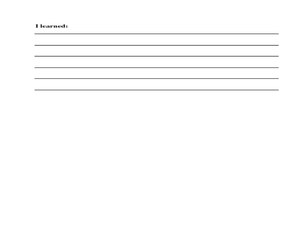Curated OER
Marine Habitats of Galveston Island
Four lessons introduce elementary ecologists to salt marsh and sandy beach habitats. In the first activity, they place shells and other materials in vinegar to determine if they contain calcium carbonate. In the second activity, they...
Curated OER
Temperature Changes Everything
Middle school chemists visit interactive websites in order to discover what happens to molecular motion when heat is added to matter. They conduct an experiment that demonstrates the expansion of matter with the addition of heat. A lab...
Curated OER
To Float or Not to Float - A Lesson on Density
Learners observe and experiment with the concept of density. This is done using a simple experiment that helps them to apply scientific principles of observation and proving a hypothesis.
Curated OER
Matter
First graders are read a story about the various stages of matter with a focus on gases. Using a ziploc bag, they capture as much air as possible and discuss how it takes up space even though it is invisible. To end the lesson, they blow...
Curated OER
How to Grow a Sunflower Plant
Students explore botany by conducting a sunflower growth experiment. In this plant life lesson, students identify the anatomy of a sunflower plant and the essential nutrients it requires to grow. Students utilize compost, soil, garden...
Curated OER
Why Is It Hotter At the Equator?
Learners investigate the different heating effects of sunlight. They conduct an experiment that demonstrates the way sunlight strikes the equator, the poles and other parts of the globe.
Curated OER
Lesson Two
Second graders, after assessing why forecasting weather is important, study about temperature and how to read a thermometer. They experiment being able to observe the mercury rising up and down when given a thermometer and cups of cold...
Curated OER
Environment: Water & Air
The introduction to the activity mentions a sailor's limited capacity to store drinking water on his ship. Pupils then set up an overnight experiment to remove freshwater from salt water by distillation. There is a math and map activity...
Curated OER
To Float or Not to Float - Density
Pupils experiment floating a variety of objects in various liquids. They discover how density affects the ability of an object to float and apply the concept of density to solve problems.
Curated OER
Groundwater Movement
Students study groundwater movement beneath the surface of the Earth. In this agriculture lesson, students experiment with how water moves through rock materials such as sand, gravel, and clay.
Curated OER
Understanding Bernoulli's Principle
Fifth graders explain why we fly. For this space science lesson, 5th graders discuss Bernoulli's prinicple and its relation to flight.
Curated OER
Animal and People Habitats
Students examine how animals create a unique space in which they can live. Students read a poem about animals' habitats discuss the habitats. They draw a space of their own and write a poem that describes their habitat.
Curated OER
Casual Pattersn in Air Pressure Phenomena
Students experiment with a jar, plastic bag and a rubber band to perform a science experiment. Students study the photocopy of Thinking About Relational Causality. Students explore the concept of a pressure-related phenomenon that...
Curated OER
Life Cycle of the Plant - The Pumpkin
First graders access prior knowledge about pumpkins and read the story Pumpkin, Pumpkin. They will sequence the life cycle of the pumpkin through the use of picture cards and then sing a song about the life cycle of the pumpkin and plant...
Curated OER
Matter
Students recognize that some changes to matter are reversible and some are not. For this matter lesson, students experiment a physical and chemical change. Students record experiment results in their science journals. Students act...
Curated OER
Balloon Rockets
Students, after reviewing and analyzing Newton's third law of motion, make balloon rockets and experiment with a variety of models. After the experiment, they chart the results and form conclusions. In addition, they compare/contrast...
Curated OER
Air Engine - Air Races
Students conduct an experiment about air volume, density, and pressure. In this air lesson, students discuss air, and how it moves. They make predictions about what will happen during the balloon and string experiment. They document the...
Curated OER
Mixtures of Matter
Students experiment with mixtures of matter. In this matter lesson, students investigate which liquids form a solution when mixed together and which do not. Students also identify which solids can be separated from matter.
Curated OER
Rocket Car
Students construct a balloon-powered rocket car from a Styrofoam tray, pins, tape, and a flexible straw, and test it along a measured track on the floor. They experiment with ways of increasing the distance the rocket car travels.
Curated OER
Mixtures of Matter
Students experiment with solids and liquids. In this mixtures of matter instructional activity, students combine matter to form solutions. Students hypothesize, test, and analyze the data to draw conclusions. The instructional activity...
Curated OER
Earth Energy Budget Pre Lab
Students explore energy by conducting an in class experiment. In this climate change lesson, students conduct a water vapor experiment in a soda bottle. Students utilize graphs and charts to analyze the results of the experiment and help...
Curated OER
Heat Transfer & Phase Changes
In this heat transfer and phase change worksheet, students experiment with ice, salt, and milk to show the relationship between the temperature of a solution and its phase. Students turn milk from a liquid to a solid and graph the...
Curated OER
Density and Mass
Students experiment to find which liquids are more dense. In this density and mass instructional activity, students predict and then test objects to observe and measure their density. students observe which items sink and float....
Curated OER
Force and Motion
Students experiment with force and motion. In this force and motion lesson, students test gravity using a variety of objects. Students rotate through a series of stations which use force, motion, friction, and inclines. Students predict...

